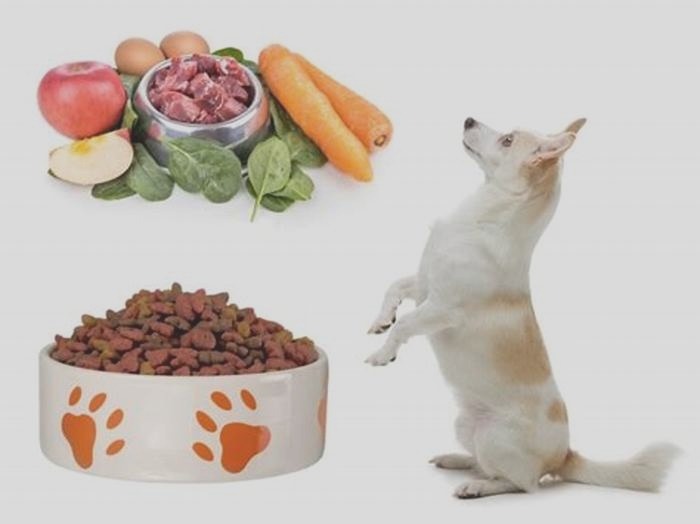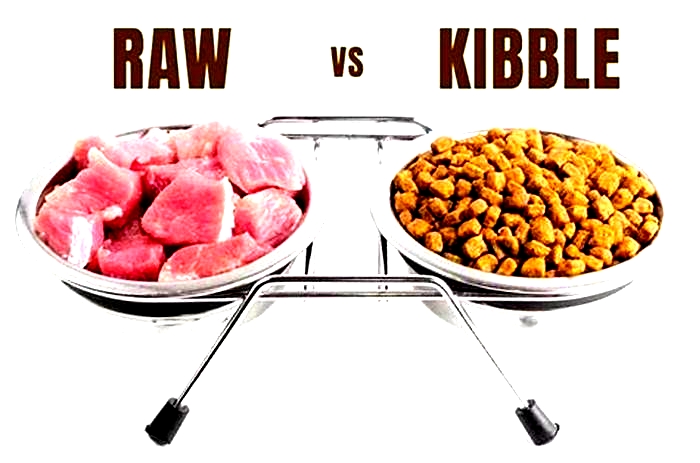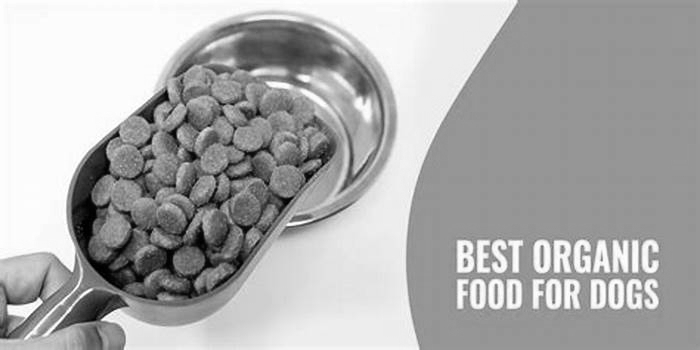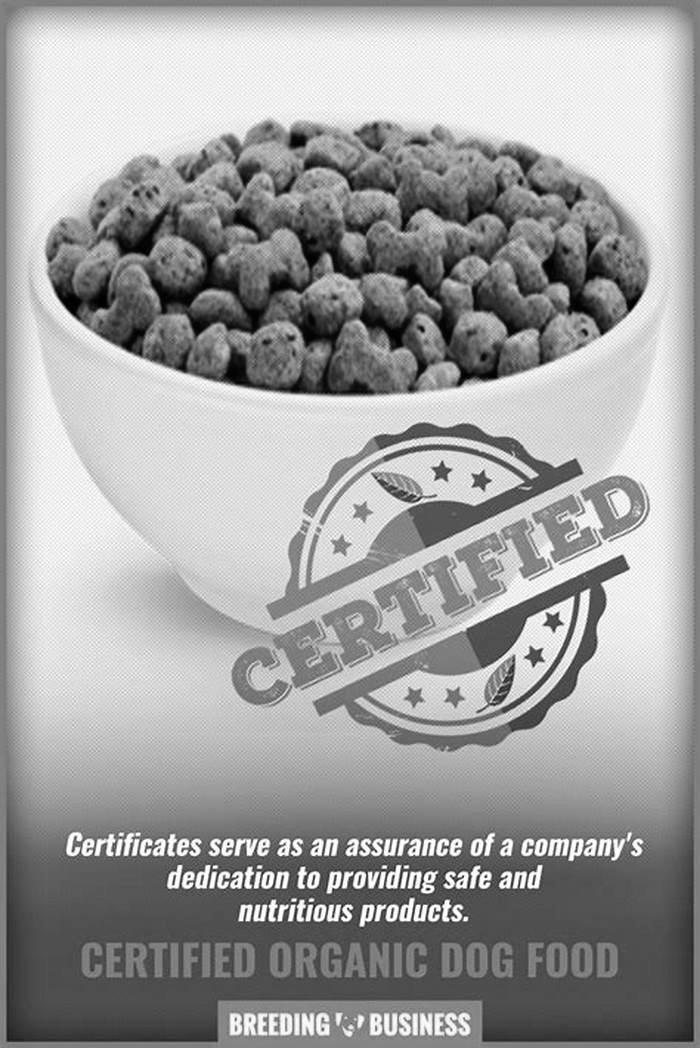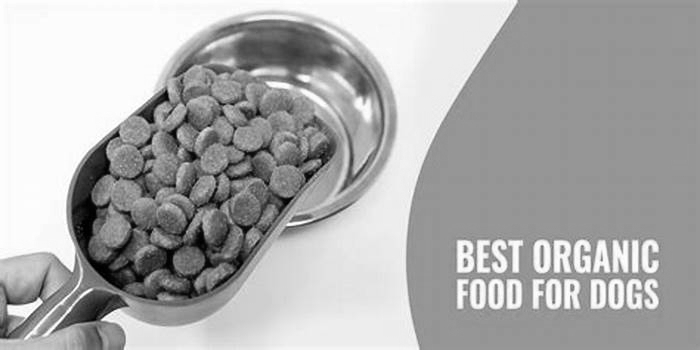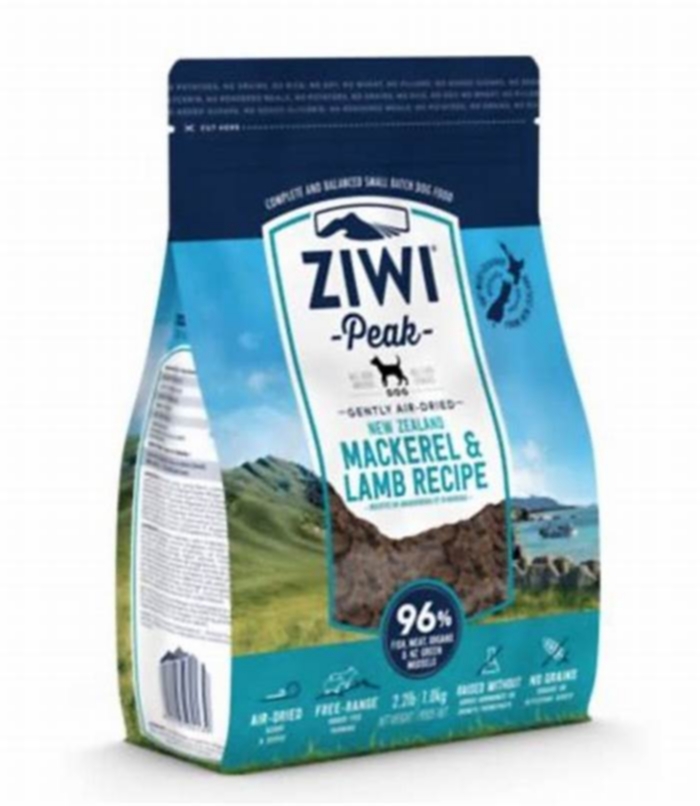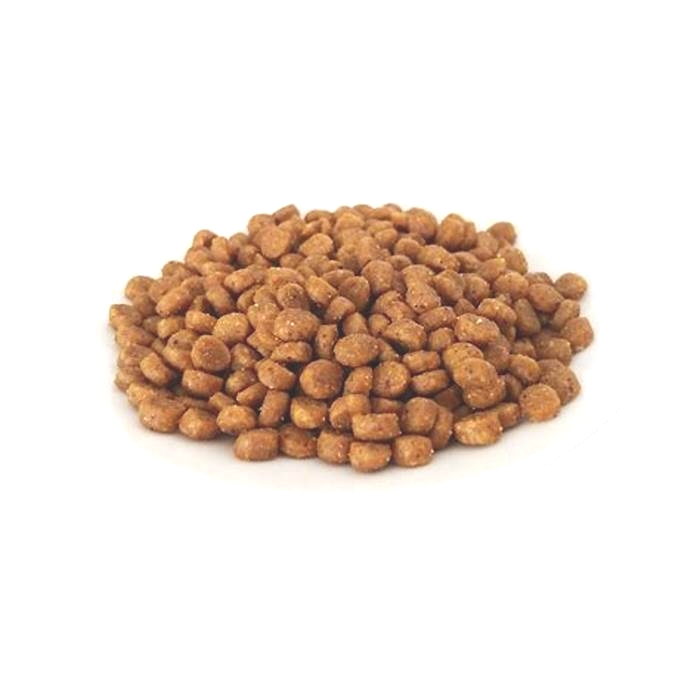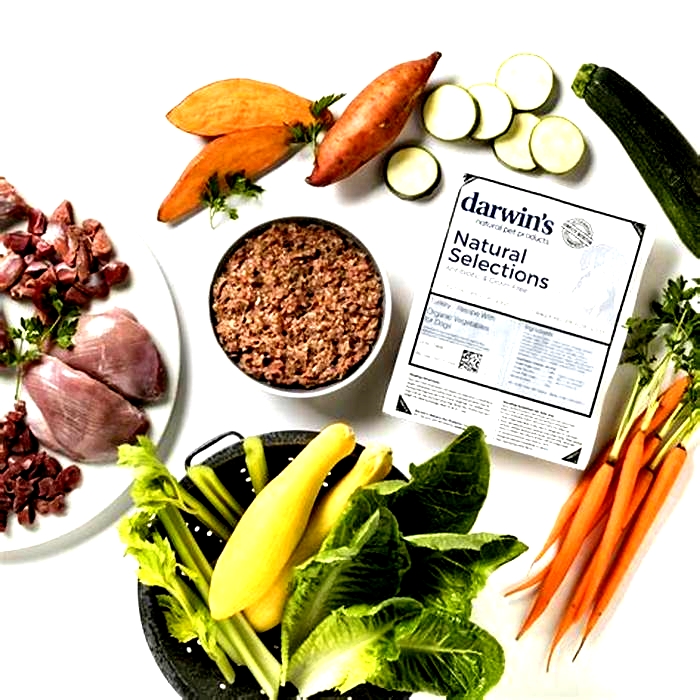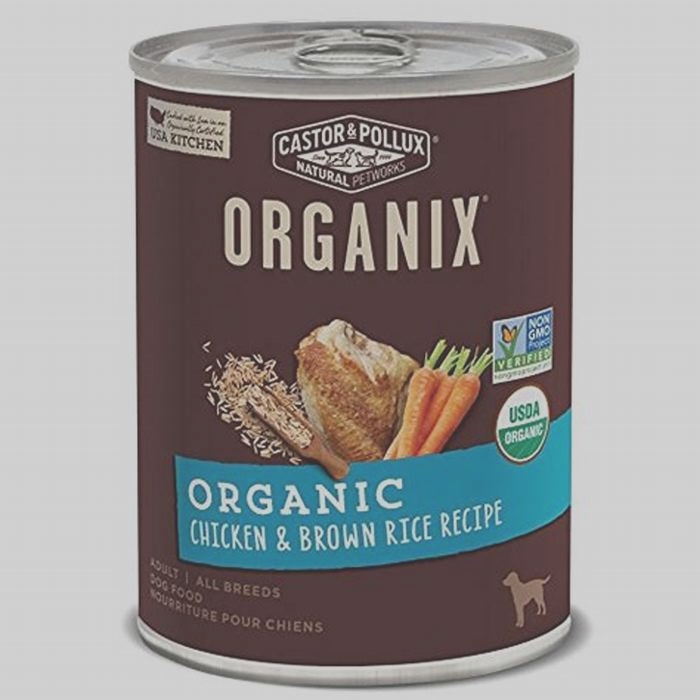Is raw really better than kibble
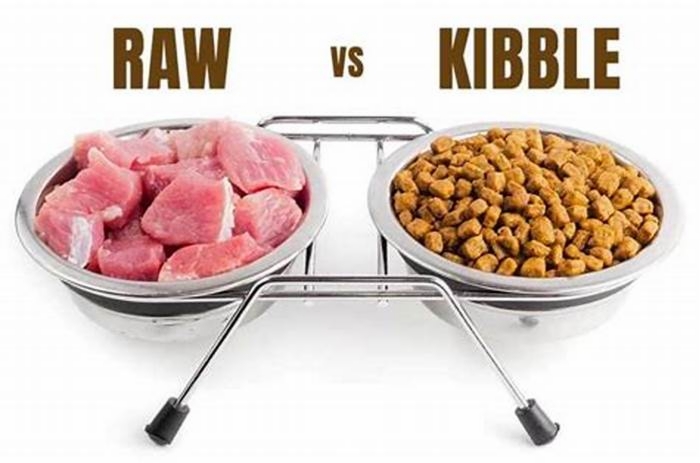
Fresh Dog Food vs Kibble: Which Should I Choose?

Picking the right dog food for your pet can be a very overwhelming process. It seems like everywhere you look you see an ad for new pet food. Its easy to get overwhelmed by all of the options.
Recently, there has been a rise in the promotion of fresh dog food delivery services. But what is a fresh food diet and should you be feeding it to your dog?
The answer: It all comes down to the individual diet and your pets needs.
This vet-written article will provide you with information on the differences between fresh dog food vs kibble, as well as what to look for when picking your pups food.
What to Look For in a Well-Balanced Diet
The most important thing to look for when picking any diet is to make sure the product meets the AAFCO standards for diet formulation. AAFCO stands for Association of American Food Control Officials.
This organization establishes standards for nutritional requirements and ingredients in pet food. Because it is not a regulatory agency, AAFCO does not directly test or regulate pet food products.
Pet food that says it is AAFCO approved, simply means that the product meets the standards set by AAFCO.
There are currently 4 possible AAFCO statements that companies may place on their pet food regarding nutritional adequacy. The most trustworthy statement involves feed trials being performed and begins with the wording Animal feeding tests using AAFCO procedures substantiate that
For more information on AAFCO and their role in pet food regulation, you can use the following link: AAFCO
You also should review the nutritional guidelines provided by the World Small Animal Veterinary Association (WSAVA). They provide educational materials for pet owners to help choose the right foods.
Another important factor in picking a well-balanced diet is to find out who was involved with the formulation of the diet.
To ensure the diet meets all nutritional requirements and AAFCO standards, your dogs diet should be formulated with the help of a veterinarian or veterinary nutritionist. Most pet food products will specify this on their label. However, the average veterinarian isnt capable of formulating a diet in the same way that a board certified veterinary nutritionist can. So, dont be easily swayed because a companys website lists a doctor as a member of their staff.
What is a Fresh Food Diet?

Fresh food diet is a very broad term that refers to less processed diets that do not contain preservatives.
While there is some debate as to whether raw food diets should be included in the fresh food category by this definition, I will only be referring to cooked food when I use the term fresh food in this article.
Raw diets can pose potential health risks to both you and your dog. If you would like to read more about the American Veterinary Medical Associations position on raw diets you can use the link: AVMA Position Statement
Why Consider a Unprocessed Meal Diet?
There are many reasons you may be curious to try a fresh food diet. Some of the most common reasons that owners switch to fresh food diets include the following:
- A desire to improve ingredient quality
- Desire to avoid preservatives
- Palatability of food
- Specific health conditions or concerns
More research needs to be done to determine if all of these reasons for feeding a fresh food diet are supported by science.
Learning more about the specific health benefits that fresh food can provide could be the most useful tool in helping you make an informed decision for your pet.
Some evidence suggests that dogs with certain food sensitivities have benefitted from fresh food diets where the problem ingredients have been eliminated.
A study on Scottish Terriers found that dogs who consumed specific fresh vegetables at least 3 times a week were less likely to develop transitional cell carcinoma of the bladder.
Studies like this suggest there may be other potential health benefits to pets consuming more fresh ingredients.
As fresh food diets become more popular, veterinarians and researchers will continue to look at how these diets may improve your pets long-term health.
Special Considerations with Unprocessed Meal Diet
One thing to be aware of when feeding a fresh food diet is that these diets typically dont contain preservatives.
Because these diets dont contain preservatives, how they are cooked and stored is especially important. Food that is not properly cooked may contain harmful bacteria, such as Salmonella and Listeria.
Food storage is also an essential component of food safety. Fresh food formulations are more susceptible to bacterial growth with fluctuating or improper food storage temperatures.
Freezing improperly cooked food does not eliminate the bacteria, and in some cases, refrigeration can even promote additional bacterial growth.
Feeding contaminated food can be harmful to your pet. Handling the food containing this bacteria can also pose a risk to your health.
Picking a Unprocessed Meal Diet
Making sure your homemade diet is balanced and meeting all of your pets nutritional needs can be a daunting task.
Many homemade diet recipes found on the internet do not meet nutritional requirements. One study evaluating these diets found that 95% of homemade diets did not meet the standards required to be considered nutritionally adequate.
For this reason, commercially made fresh food diets are a great alternative.
When picking one of the commercially available diets, you should use the same tools previously discussed to pick a well-balanced diet.
Because of the risks associated with preservative-free products, where and how the food is cooked and processed is particularly important for evaluating fresh food diets.
The Pros and Cons of Unprocessed Meal:
Here are the pros and cons of fresh food when comparing fresh dog food vs kibble:

Pros:
- Customization: Many of the subscription-based fresh food companies offer personalized meal plans. The company will ask you to fill out a short questionnaire about your dog. Based on your pets ideal weight, breed, and activity level the veterinary nutritionists can customize the diet to your pets needs.
- Portions: Many of the fresh food diet markets on the market are delivered in pre-portioned packages. This packaging is great for taking the guesswork out of how much to feed your dog. It is important to note that most companies provide a full days worth of food in each package, so make sure you divide your pups meals up accordingly.
Cons:
- Storage: Fresh food must be kept refrigerated or frozen so you need to make sure you have adequate room for storage.
- Safety: For most home delivery options, once the food is cooked it is shipped frozen to your door. Because the product contains no preservatives it is important to double-check the temperature of the product when it arrives. If you have any concerns, check with the company to make sure the food is safe to feed your dog.
Why Feed a Kibble Diet?
There are many reasons that kibble has long been a staple in the pet food industry. Dry dog food has many benefits including:
Dry dog foods contain preservatives that make them safe to store at room temperature for longer periods of time.
- Increased calorie density compared to wet or fresh food diets:
One of the biggest differences between kibble and fresh food diets is calorie density. As a general rule, for your dog to get the same amount of calories that they get from one cup of dry dog food, they will need to consume a larger quantity of fresh food.
Calorie content varies for every dog food formula. Every diet should contain a label that details the calories per cup or per kilogram of food to help you determine how much you will need to feed your dog.
Picking a Dry Food Diet

When picking a kibble diet, I prefer diets from one of the larger companies, such as Purina or Royal Canin. Hills Science Diet is another good one. This is not to say that smaller companies dont have quality products.
Purina and Royal Canin have a long-standing history and reputation for quality nutritional products, which is an important factor in my recommendations.
The larger companies tend to have more research behind their products, as well as experience with safety regulations and quality standards.
Just like evaluating fresh food, to pick the right kibble diet you need to look for the AAFCO statement and information on how the diet is formulated.
Whether its from one of these big names or a smaller company, always talk to your veterinarian if you are interested in changing your dogs food.
They can answer any questions you may have about the specific product and determine if its appropriate for your pup.
The Pros and Cons of Dry Food
Here are the pros and cons of a kibble diet:
Pros:
- Availability: Kibble is the predominant type of dog food available in local pet stores, although refrigerated fresh food options are available in some locations.
- Cost: As a general rule, kibble is significantly less expensive than fresh food.
Cons:
- Palatability: Although Purina provides a wide variety of flavor options, fresh food typically has a wet or semi-moist consistency. This makes fresh foods more palatable to most dogs.
- Processing: While more and more kibble brands are moving away from using artificial preservatives in their product, kibble contains more preservatives and is more heavily processed than fresh food.
Conclusion
At the end of the day, the most important thing is that your dog is consuming a safe and nutritious diet.
While some owners have seen that their pet has benefited from a fresh food diet, more studies need to be done to determine the full extent of these benefits.
Hopefully, this article will provide you with a better understanding of fresh dog food vs kibble, as well as the potential benefits and concerns.
As always, if you are considering making changes to your dogs diet, talk to your veterinarian to create a plan that is right for your pet.
Sources and additional reading:
Stockman, Jonathan et al. Evaluation of recipes of home-prepared maintenance diets for dogs. Journal of the American Veterinary Medical Association vol. 242,11 (2013): 1500-1505. https://doi.org/10.2460/javma.242.11.1500
Raghavan, M., Knapp, D. W., Bonney, P. L., Dawson, M. H., & Glickman, L. T. (2005). Evaluation of the effect of dietary vegetable consumption on reducing risk of transitional cell carcinoma of the urinary bladder in Scottish Terriers. Journal of the American Veterinary Medical Association, 227(1), 94100. https://doi.org/10.2460/javma.2005.227.94
Kibble vs. Raw (Which Dog Food is Better?)
Kibble is seen as the default dog food by most dog owners. Anything dog owners eat is seen as the default dog food by dogs.
But if youre confused about what to feed your dog, you do have a few options other than kibble and dinner scraps. Raw dog food is one of these options and is worth comparing to kibble. So which is better, kibble or raw?
Kibble excels in delivering precise macronutrients, saving money, and offering ease of storage, whereas raw dog food stands out for its ability to provide energy, enhance bone and joint health, and stimulate your dogs interest in their meals.
When comparing kibble and raw diets, kibble tends to be the better choice for most dogs. Both have pros and cons, and you must consider them before choosing one.
In this article, we will discuss dry dog food vs. raw dog food. By the end of this post, you will have the full picture and can decide what works for you.
One thing to mention is that when Im talking about kibble, Im referring to a good-quality brand that is complete and balanced per theAAFCO dog nutritional requirements.
Lets get started!
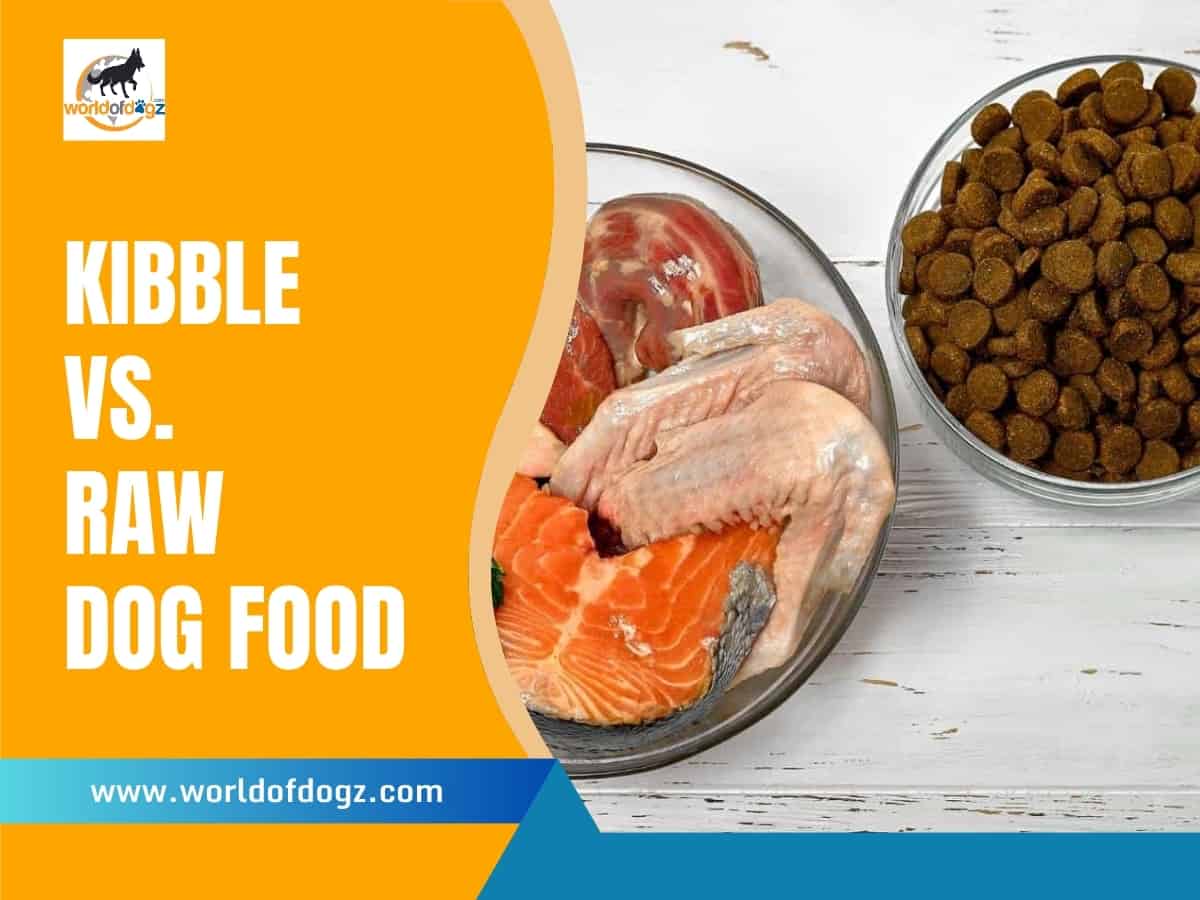
Pros and Cons of Kibble
| Pros of Kibble (vs. Raw Dog Food) | Cons of Kibble (vs. Raw Dog Food) |
|---|---|
| It is formulated to contain the nutrients your dog needs | It is cost effective |
| It is easy to store and carry | Some brands use cheap ingredients |
| Better for dental hygiene | Low moisture content |
| It is cost-effective | Some fussy eaters might reject it |
| It has a long shelf life | Top brands can be expensive, especially cold-pressed varieties |
Kibble: A Brief Overview
The word kibble originally meant to chop coarsely. Today, it refers to dog food that is formulated to be nutritious.
It is not chopped coarsely, but its size does match its ancestors meaning. Kibble generally serves canines but is often produced for specific breed sizes and life stages.
There are three main types of kibbles in terms of nutritional value: small dog kibble, medium-sized dog kibble, and large dog kibble. Each type has a puppy, young adult, and senior dog variations.
Kibble is one of the most popular commercial dog foods, but its popularity can often be limited to dog owners and may not be shared by dogs.
Depending on how fussy your dog is, you may love or hate kibble. Fortunately, kibble isnt the only type of dog food.
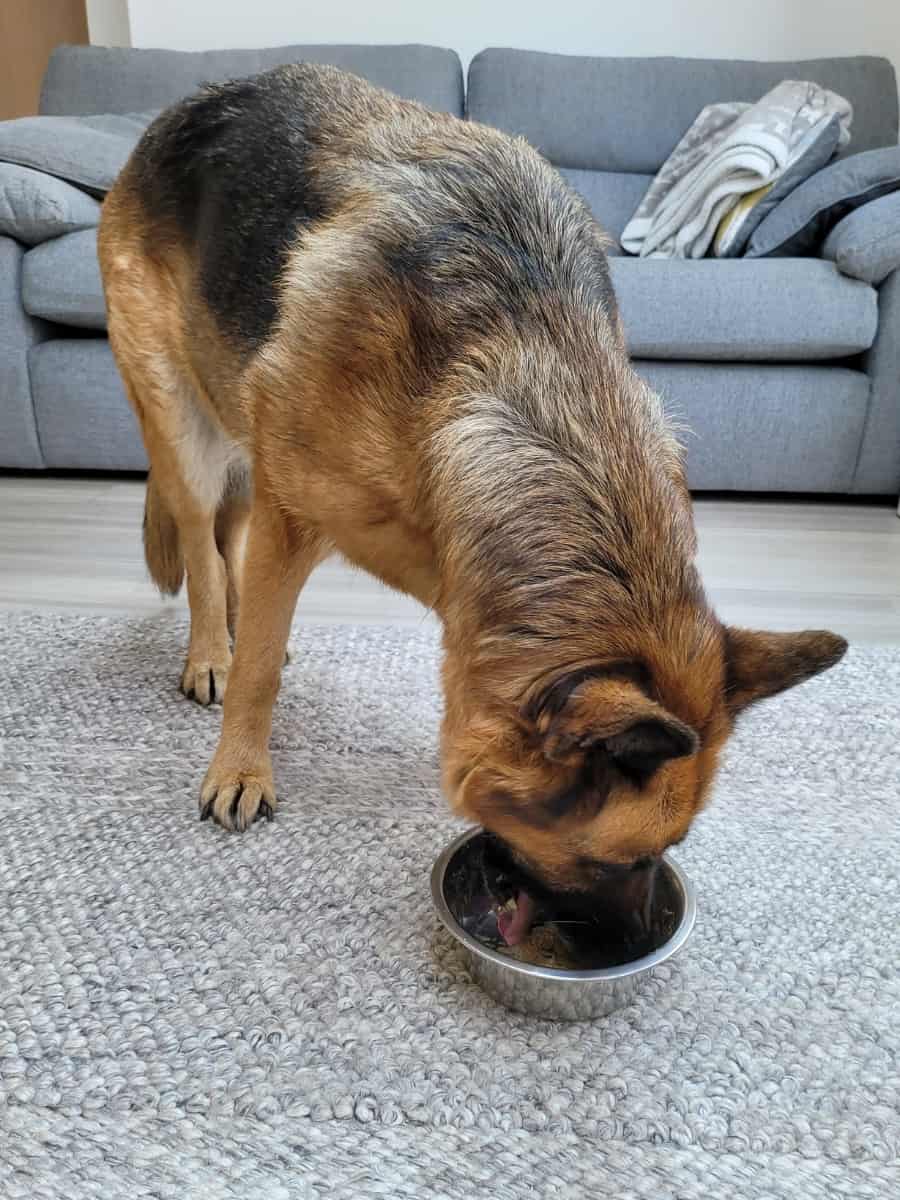
Pros of Kibble
Lets go over some of the advantages of kibble, some of which are responsible for it being a staple in my dog Willows diet.
You will notice that the most perceivable benefits of kibble are for the owner. And how kibble is good for the dog cant be perceived by him.
It Is Nutritious
Kibble often packs just the right amount of calories and macronutrients for your dog. It is, therefore, easy to feed your dog dry food without undernourishing or overfeeding him.
Since dogs cant understand how much kibble helps their health, this benefit doesnt translate into hunger. We will cover that in the drawbacks section.
It Is Easy To Store/Carry
This is an advantage that your dog can probably get on board with. You can carry kibble wherever you go. It isnt terribly aromatic and doesnt go bad at room temperature. That said, your dog might not accept it as a high-value treat.
Dry dog food has a long shelf life due to the added preservatives. Unopened kibble lasts 18 months, while opened dry dog food packaging lasts 4-6 weeks.
Better For Dental Hygiene
Kibble is great for your dogs dental hygiene because it is not soggy. As a result, it doesnt get lodged between his teeth at least as much as raw dog food.
Kibble can also scrub off previously stuck food, helping maintain a clean oral environment.
Cost-Effective
Kibble is at least five times cheaper than wet food; depending on the raw food you compare it to, it can be 3 to 9 times more cost-effective.
Since everything about a dogs lifestyle centers around a sustainable routine, a diet featuring kibble can be easier to maintain from a budget perspective.
Do you want to know how much it costs to feed kibble? Head over to this article, How Much Does Dog Food Cost a Month?
Long-Lasting
Kibble has the advantage of being dry, which makes it last longer than wet dog food and raw dog food. The only comparable dog food in terms of longevity would be freeze-dried because it, too, is free of moisture.
Raw vs. Kibble? Watch This Video To Learn Which Is The Best
Cons of Kibble
Kibbles advantages are its convenience and sustainability, while its drawbacks are mainly its low adaptability.
I have yet to see a dog be more interested in kibble than raw or home-cooked dog food. Lets look at the disadvantages of kibble in a little more detail.
It Contains Highly Processed Ingredients
Kibble is as processed as dog food can get. While maintaining macronutrient ratios is one of the critical factors in the kibble formula, producing pellets that can be stored for a long period requires chemical preservatives.
These can affect your dogs health in the long run, especially if he relies on a pure kibble diet.
Cheap Ingredients
The fact that most kibble is cheap cannot coexist with the fact that high-quality ingredients are expensive. Kibble relies on feed-grade ingredients that pass the bare minimum requirements to qualify as food.
Of course, trusted kibble brands use higher quality ingredients and charge more for them. But generally, kibble makes it easier to mask cheap ingredients. In contrast, you can tell when raw food has low-quality ingredients.
An healthier alternative type of kibble is cold-pressed dog food and this is the type of dry food I feed my German Shepherd. World of Dogz
Cold pressing produces complete dog food at lower temperatures, allowing the natural ingredients to retain all of their nutritional value, flavor, and aroma and the essential vitamins for digestion, growth, and good health.
Many dog owners see cold-pressed dog food as a great alternative to raw. The lower temperatures used in the cooking method retain essential nutrients, but its easier and more convenient to feed.
Low Moisture Content
Kibble is dry and can be unappealing to your dog for this reason. As mentioned in my post about whether dogs like their food, they have specialized tastebuds to taste water. The wetness of food is a part of their feeding experience.
Since kibble is dry, we can assume that dogs find it less appealing. You can offset this by adding water to the kibble or mixing wet food items or toppers with it. Such mixing isnt required for wet dog food.
My dog loves a little warm water added to her dry food, turning it into a thick gravy. She benefits from added hydration, increased aroma, and better palatability.
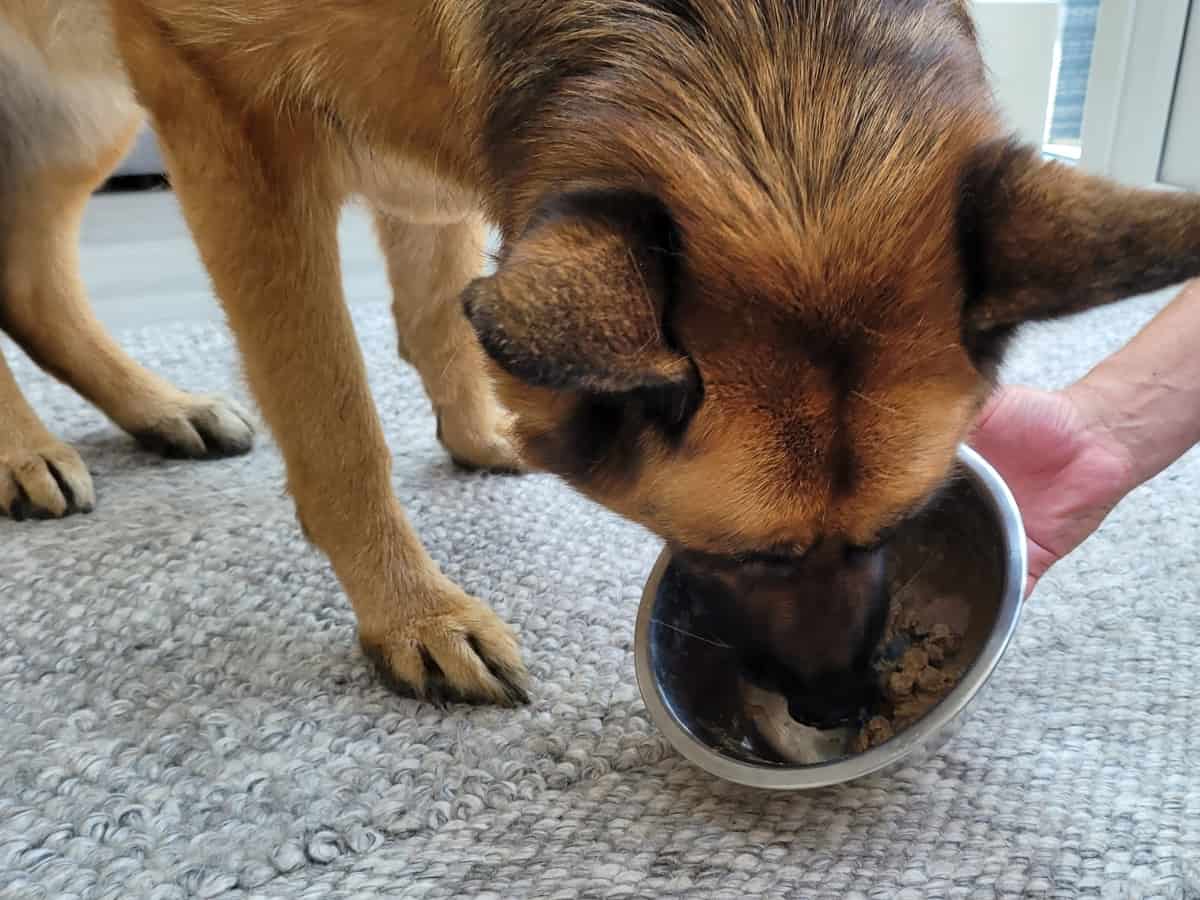
Your Dog Might Reject It
Because of low moisture content and a lack of aroma, dogs arent inherently interested in kibble as much as they are in other food items. In most cases, your dog might not finish a bowl full of kibble alone.
But there are instances where your dog will completely reject dry dog food. When your dog prefers being hungry over consuming kibble, you know that no advantage of kibble is worth feeding it to your dog.
Read more: Is Kibble Bad For Dogs? If So, Why?
Should I Feed Kibble To My Dog?
Now that you know the pros and cons of feeding kibble to your dog, you can see that it can be a convenient choice. However, it is not a universal choice, so other forms of dog food can exist.
You should feed your dog kibble if you can source high-quality kibble that matches your dogs life stage and breed size and your dog accepts it.
If your dog rejects it, you might need to add a topper or opt for an alternative type of dog food.
Best practices for feeding kibble to your dog:
- Moisten the kibble From water to wet food, you have plenty of options for adding things to the kibble to make it moist. Dont limit your dogs food intake to dry kibble.
- Dont neglect vitamins and minerals Vitamins, minerals, and fiber are pretty important alongside essential fatty acids. Ensure to include food items that contain vitamins and fiber to raise a healthy pet.
- Balance your convenience with the dogs needs and preferences A pure kibble diet is one of the most convenient ones for dog owners. But as covered earlier, your dog might prefer wet food. Make sure that you balance what your dog needs with what he wants, or he will reject kibble.
- Dont force particular kibble products on your dog Dont get so strict about the nutrition that your dogs diet becomes tyrannical. Try to make his eating experience as enjoyable as you can. The more he can enjoy his food, the less effort you need to make him have it.
Pros and Cons of Raw Dog Food
| Pros of Raw Dog Food (vs. Kibble) | Cons of Raw Dog Food (vs. Kibble) |
|---|---|
| It is appetizing | It is hard to store |
| It contains high levels of protein | It can get contaminated easily |
| Can be more holistic | Difficult to maintain the correct nutrients (unless you seek expert advice or buy frozen) |
| It promotes superior joint and bone health | Can be expensive |
| Reduces poop volume and odor | Preparation of food is time-consuming |
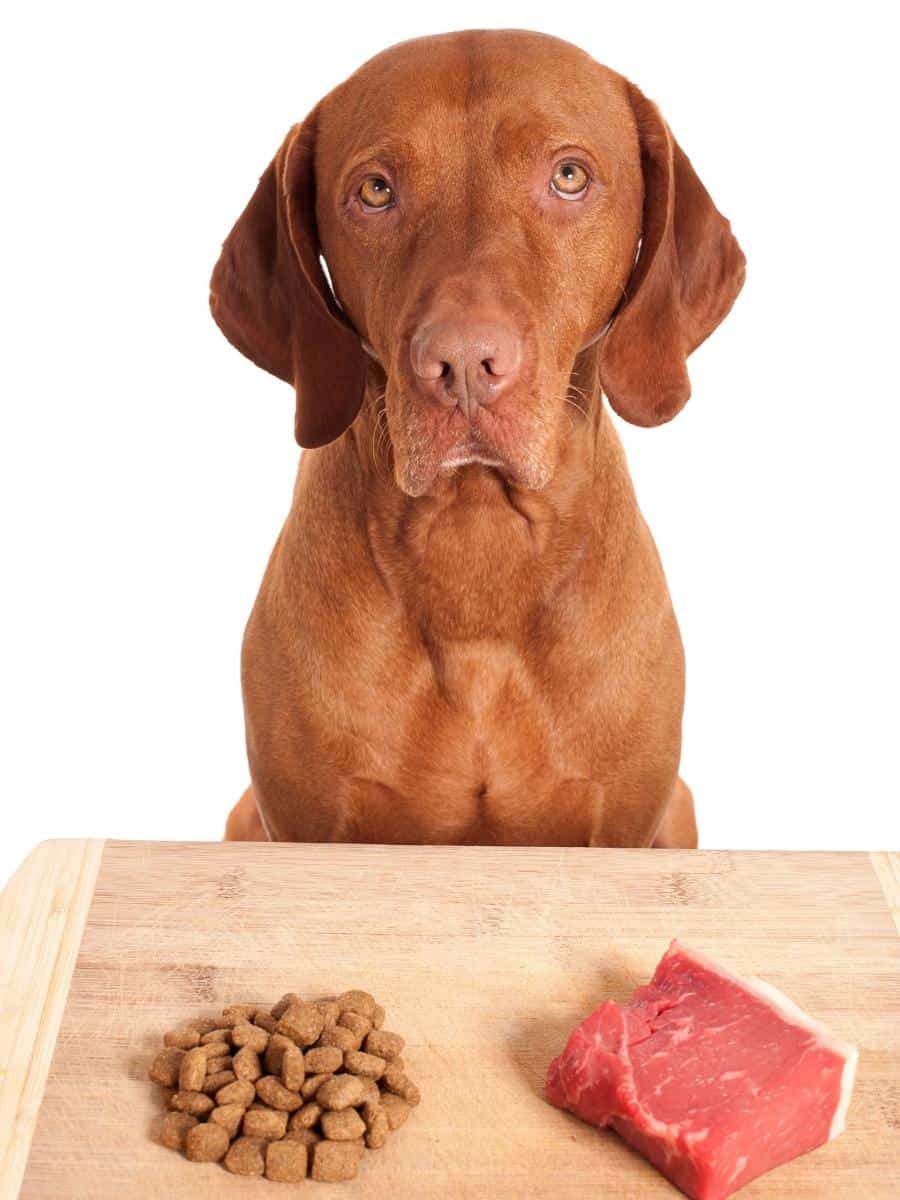
Raw Dog Food: A Brief Overview
A raw diet is, as the name suggests, a diet made up of raw food. Since dogs have a carnivorous bias, they are more than happy to consume meat, which is a significant part of the raw dog diet.
You need to pay attention to two similar-sounding terms regarding dog food and raw ingredients.
Raw dog diet and raw dog food can seem interchangeable but vary significantly.
Raw dog food refers to store-bought or homemade raw uncooked items that can be consumed raw. It can also refer to freeze-dried dog food, which is raw food with moisture extracted from it for easier storage.
A raw dog diet consists of 100% raw ingredients. You can mix raw dog food with kibble or wet dog food. But you cannot mix anything processed or cooked with raw dog food if your dog is on a raw diet.
Since the pros and cons of kibble were addressed from a kibble-only standpoint, the pros and cons of raw dog food will also be viewed from a raw-only perspective.
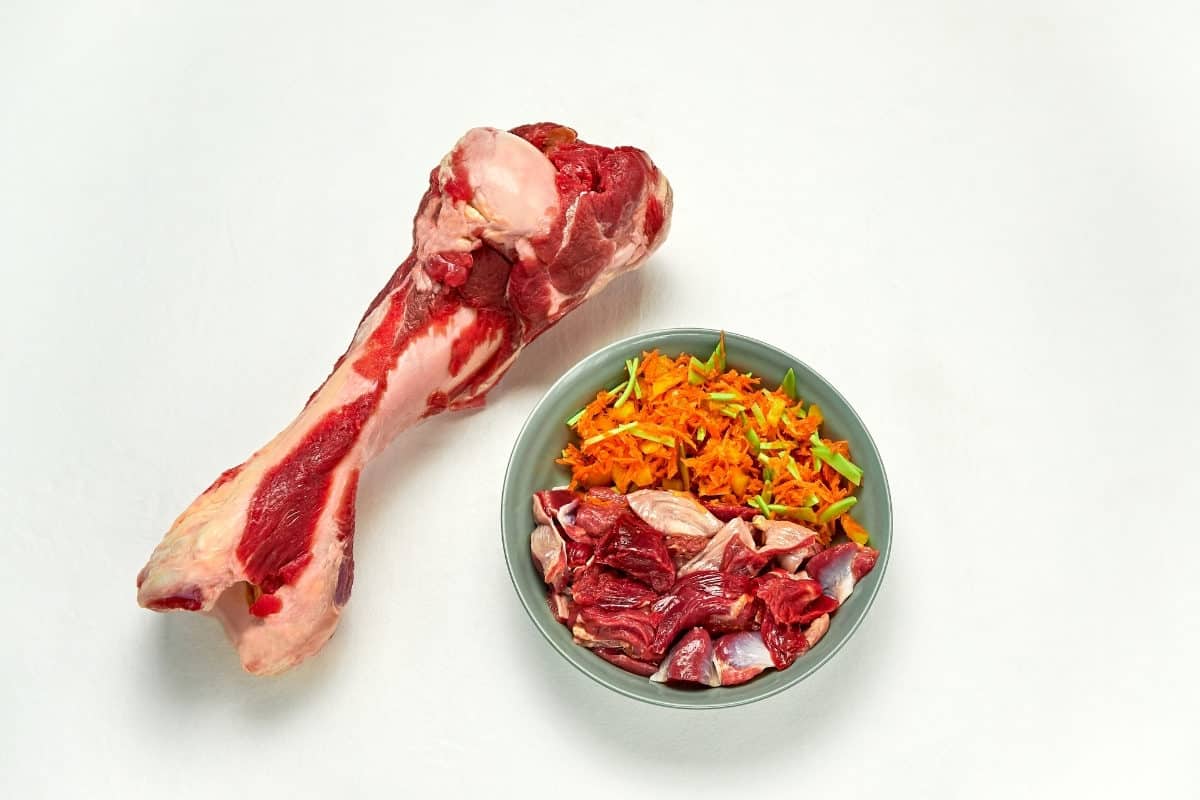
Pros of Raw Dog Diet
Raw dog food is said to have many benefits, like promoting healthy skin and a shiny coat.
However, since these benefits arent backed by anything other than owners anecdotes and claims, we will not include them in the pros of a raw dog diet. Instead, we will go by what is verifiable. Here are the main pros of a raw dog diet.
It Is Appetizing
Since most raw dog food contains meat, and dogs have a carnivorous bias despite being omnivores, a raw dog food diet is very appetizing.
Dogs rarely reject a diet featuring meat, and you dont have difficulty getting them to accept food. In fact, they end up begging you for more.
It Contains High Levels Of Protein
Once again, this benefit stems from the presence of meat in a dogs diet. The more meat in the dog food, the better for your dogs health.
This is true, especially if your dog is big. Bigger dogs need more protein to maintain their muscle mass.
The protein content helps build lean muscle, benefits new cell generation, and builds immunity. Having said that, it is worth remembering that dogs also need other macronutrients besides protein.
It Can Be More Holistic
Fortunately, raw food features fats and carbs as well. You can add veggies and yogurt to the raw dog food to promote better gut health and incorporate vitamins into the diet.
A raw dog diet assumes a more involved owner, increasing the odds of the diet being more holistic.
It Promotes Superior Joint And Bone Health
Regardless of your dogs diet involvement, if you feed him raw food, you automate his joint and bone health. Meat intake has a direct correlation with joint and bone health in dogs.
Technically, raw food can consist of just vegetables, so this benefit is contingent on the amount of meat in the dogs diet.
It Reduces Poop Volume and Odor
Raw dog food results in less smelly poop. This might be because of no preservatives and closer-to-nature ingredients in the dogs diet.
You can tell the difference between a dog who consumes raw food and a dog who eats kibble by simply looking at the stool volume and consistency.
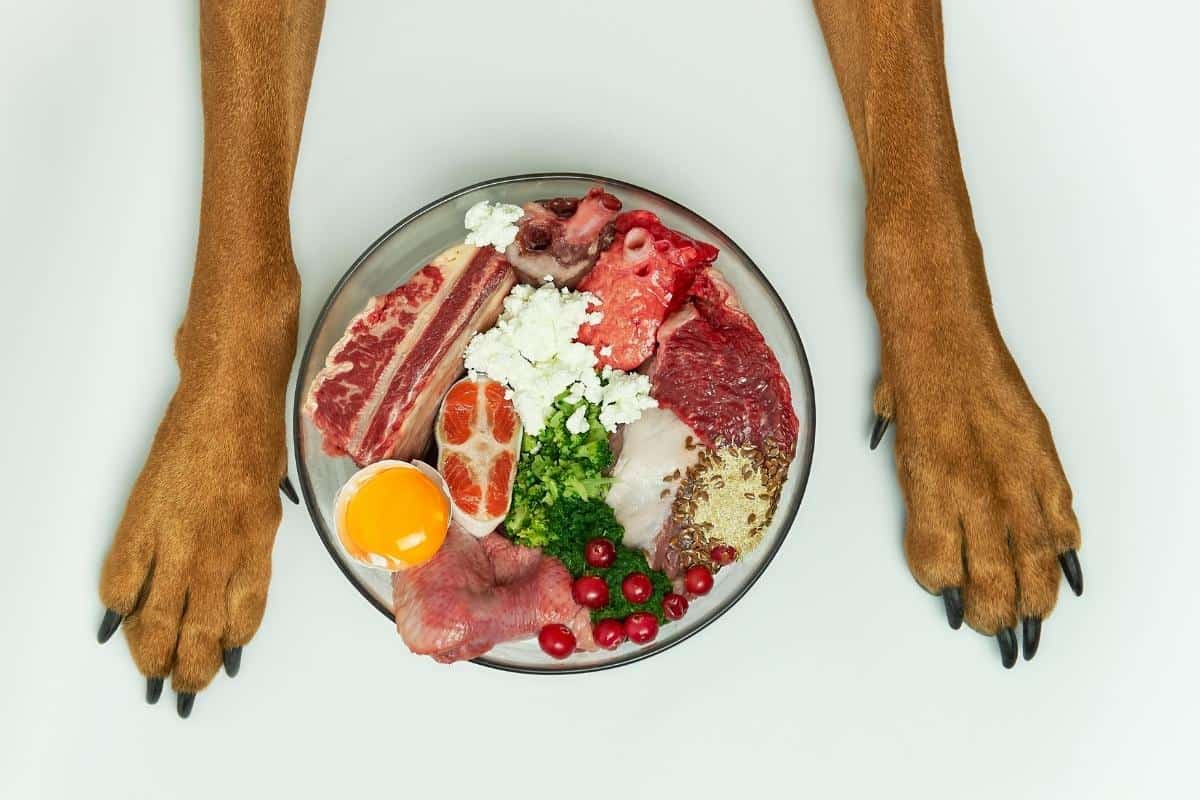
Cons of Raw Dog Food
Raw dog food is getting pretty popular. However, it doesnt have most of the dog food market share simply because it is limited in multiple ways.
In this section, I will review some of the most common disadvantages of feeding your dog an exclusively raw diet.
It Is Hard To Store
The first problem with raw dog food is that it is a hassle to store. Human food is also a hassle to store, but we can refrigerate and microwave food whenever it is storing or feeding time, respectively.
Storing dog food can be complicated when you cannot cook it or heat it up.
It Can Get Contaminated Easily
Continuing on the theme of storage, the meat content of the raw diet is as vulnerable as any edible item can ever get. It is one of the most vulnerable types of food when it is not cooked, and almost any bacteria can survive.
This latest study review on raw diets concerning microbiological hazards highlights that the prevalence of potentially serious germs is considerably higher in raw pet food than in heattreated food.
Also, the CDC does not advise a raw food diet for dogs due to health concerns around pet food safety, and this is justified, according to the above study.
However, it is accepted that more research is needed on the health risks and nutritional benefits of raw feeding.
Your Dog Can Become Overweight (Or Underweight)
Another problem with raw dog food is that it is hard to pinpoint its nutritional information. The only exception seems to be in freeze-dried or raw frozen food.
Packages of freeze-dried and raw frozen dog food can be categorized by dog breed and life stage. But if youre using raw meat and dairy to feed your dog, even your most accurate guess is still a guess.
It Is Expensive To Maintain
Finally, the greatest disadvantage of a raw dog food diet is also the one that can limit anything from becoming a global phenomenon: it is too expensive.
Depending on the ingredients you use for your raw dog food recipes, you might spend 3 to 5 times more per month by choosing it over kibble.
Do you want to know how much it costs to feed your dog a raw diet? Check out this article, The Cost To Feed Raw Dog Food (The True Price!).
Preparation of Raw Food is Time Consuming
Feeding your bestie a raw food diet takes time and preparation. As germs like listeria and salmonella bacteria are a risk, you must take food safety precautions to prevent your dog or your family from becoming sick.
Whenhandlingrawpetfood,youmustproperlywashyourhandsandanysurrounding surfaces.
Preparing, sanitizing, and researching proper raw food feeding takes a long time.
Home-prepared raw food might not be for you if you dont have the time to become a part-time dog nutritionist and maintain your dogs area like a commercial kitchen!
Mixing Kibble With Raw Dog Food (A Compromise!)
If youre still undecided about whether to feed kibble or raw, the best alternative option is to feed the hybrid diet a mix of dry dog food and raw.
For example, add some pieces of lean chicken or meat with dog-friendly vegetables to your dogs dry feed. This can make a perfectly digestible and healthy meal.
However, when combining the two diets, if youve only fed dry food to your dog, you must slowly add small portions of raw food when transitioning to a kibble and raw hybrid diet.
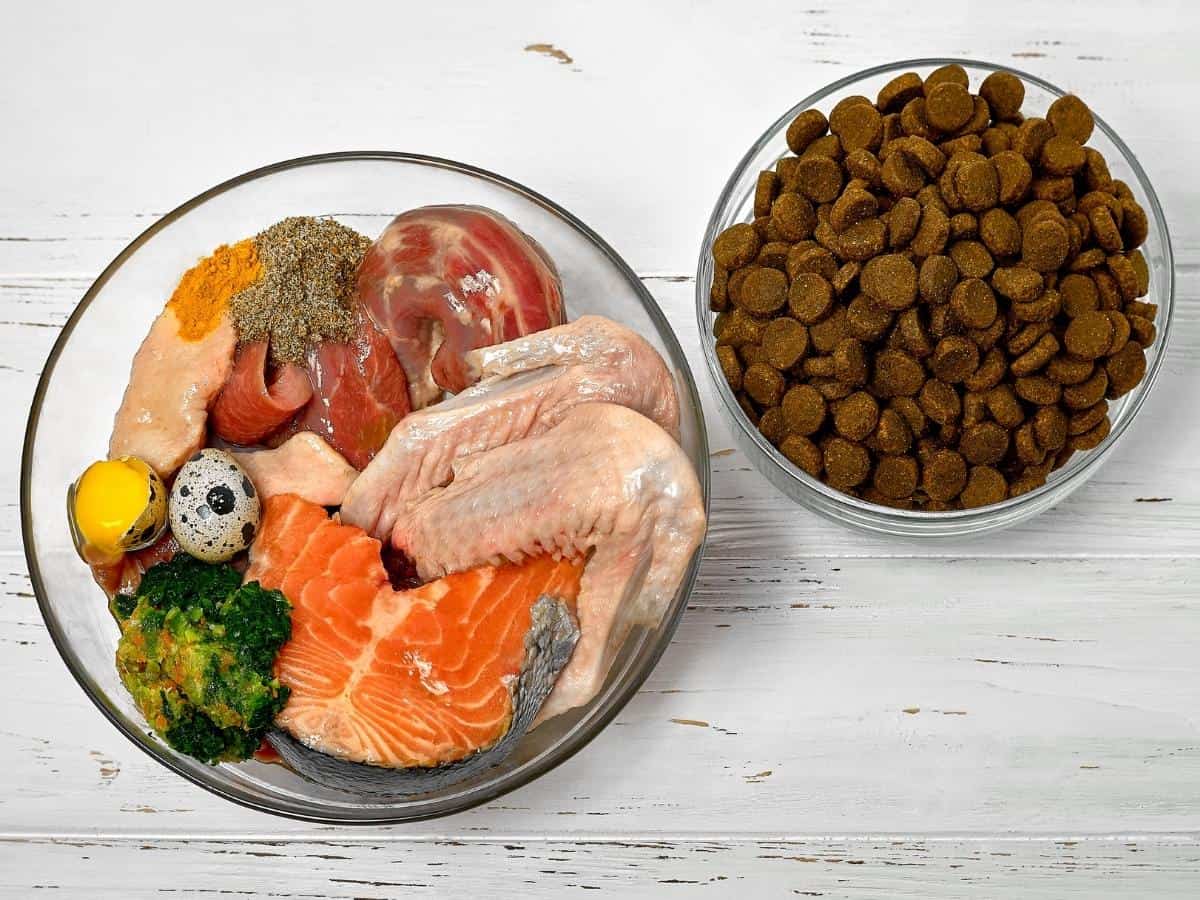
Final Thoughts
In a kibble vs. raw dog food discussion, kibble is inexpensive and easy to get right with minimal effort. Raw dog food is more appetizing and holistic but requires a lot of hygiene care and significantly higher investment.
A mix of the two can be a mid-way solution, but ultimately, your personal context, your dogs needs, and his preferences determine which one is best for you.
And if youre not entirely convinced about raw feeding, you might want to check out my post on the pros and cons of dry dog food vs. home-cooked dog food, Kibble vs. Homemade Dog Food (Which is Better?)
Related Posts You May Like:

